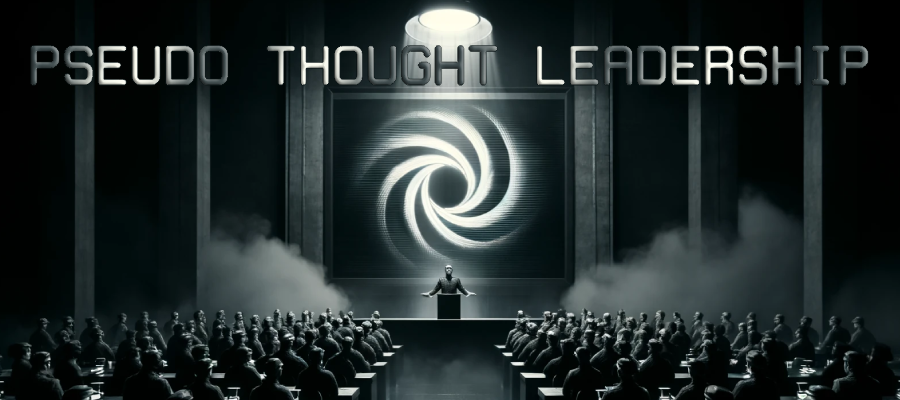Thought Leadership Lost in a Sea of Repetition
Lately, I feel like I’m in the Twilight Zone! In a week spent on social media (especially LinkedIn), one can’t help but notice a multitude of self-proclaimed “thought leaders” echoing identical sentiments. This phenomenon begs the question: how can supposedly original thinkers share the exact same ideas all the time?
The truth lies in plain sight – the novice “experts” trying to make a name for themselves. These individuals usually repackage stolen content as their own, driven by the allure of likes and shares. Some merely recycle popular posts with a cursory “Agree?” or “100%,” while others shamelessly copy-paste a quote from a meme onto a different image, laying claim to its brilliance with a big fat picture of themselves. There seems to be a free-for-all in the ongoing Meme Wars. Here I sit, longing for the days of honor and integrity.
Curiously, an alarmingly large audience engages with these posts, liking, sharing, and commenting on them as though they haven’t seen them thirty times in the last week. And don’t get me wrong. I recognize the value of sharing content. That is not my complaint here. The complaint is when people pass content off as their own or pretend to be thought leaders because they hit the share button. It’s sort of like a former student of mine who took meticulous notes during my class, graduated, and then suddenly became a “coach” offering similar services. It’s just wrong!
Sharing articles and posts is great. Stealing them as trying to convince the world that you came up with it is another. Authentic thought leadership is a far cry from this mimicry. In fact, this trend represents the antithesis of genuine thought leadership. But what baffles me is not just the counterfeit content creators but also the audience that endorses them without giving anything a second thought. I mean, was there any thought that perhaps the meme that made you feel validated might be inaccurate? I’m guessing “probably not.”
Thought leadership involves presenting original ideas or providing a fresh spin on existing ones, offering innovation, insight, or a unique perspective. This might involve building upon concepts or challenging prevailing norms. Regardless, authentic thought leadership never involves unabashedly appropriating popular memes and posing trite questions like “Do you agree?” just to get some shares.
A genuine thought leader is recognized as an authority in their field, often coupled with the ability to contribute novel, creative, and valuable insights. Of course, not every instance of thought leadership has to be revolutionary, but it should always offer something new. And by the way, that “new” part should be the emphasis.
The issue at hand is this: authentic thought leadership necessitates novelty. True thought leaders distinguish themselves by their forward-thinking viewpoints, ability to connect disparate concepts, and willingness to propose solutions that defy conventional wisdom. In essence, they attempt to shake up established norms within a specific realm of knowledge. There’s only one problem with that, and it’s a big one.
How Can You Know?
Allow me to pose a question. How do you know if someone is a real thought leader or not? Well, if it instantly resonates, that’s probably a warning. I hate to say it, but the answer probably lies in their lack of popularity. Before I clarify that, let me qualify it with a simple distinction. There is a big difference between being disliked because you’re a thought leader and being disliked because you’re unlikable. That said, we can continue.
Genuine thought leaders seldom enjoy widespread popularity because… they disrupt the status quo. Change inherently breeds uncertainty, a discomfort that many people shy away from. I probably don’t have to tell you that familiarity with the contorted present far outweighs the allure of any novel accuracy. I mean, just look around. We are living that reality every day. Only now, everyone is an “agent of change,” but nothing changes. Instead, we see an exacerbation of the status quo. Everyone is a leader hell-bent on following. Again, it’s the Twilight Zone.
Okay, here’s the situation. Change introduces chaos, threatening one’s sense of control over their environment, processes, and roles. People instinctively resist this loss of control – and those advocating it. The psychological dissonance that arises from reconciling conflicting information also fuels resistance. Sometimes, resistance serves as a shield to safeguard prior decisions. For example, wrapping an entire identity into a flawed idea. If this person embraces the uncomfortable truth, they will likely have to change their identity. Most are not willing to face that. And yes, these examples go on.
The term “thought leaders” is almost a cuss word or a cut-down if it is said in accuracy. If you truly are a thought leader, then that likely means that your ideas will be avoided, ignored, or even persecuted by the masses. Of course, the followers of true thought leaders tend to be loyal intellectuals who appreciate the unique insights they bring rather than the masses seeking confirmation bias. So, while not widely popular, the peeps you do have are pretty awesome. No worries. Just recite this ancient Greek philosophy: “If you want to be wrong, then follow the masses.” Somehow, that seems to say it all.
Understand that real thought leaders aim to steer initiatives and inspire fresh perspectives, endeavors that often encounter resistance. It’s a double-edged sword, to the point that the term “thought leader” has, ironically, turned into a pejorative. Shunned by the majority, and resonance among the intellectuals. Just remember that quality is usually better than quantity.
This is common, though. Consider the plight of actual thought leaders – Galileo, Socrates, Thomas Paine, Giordano Bruno, Joan of Arc, Julian Assange, Alan Turing, Snowden, Rachel Carson, Ron Paul, Nikola Tesla, and many others. Notice a theme? Their legacies were born from adversity, often enduring persecution, isolation, or even death. Many of these people died broke and alone. They tried to change the world, and some got close, but ultimately, the world paid them a certain price for trying. That is what true thought leadership looks like. It’s unpopular, it’s lonely, and it’s frustrating. And then, long after that idea is no longer a threat to the fragile masses, that idea will eventually be “adopted” and shared… and then often misattributed as someone else’s idea.
Modern tribalism only further complicates matters. Deviating from the masses can lead to being canceled or ostracized. This paradox only underscores my core assertion. How exactly is someone a “thought leader” when all they do is parrot what is being fed to them in their self-selected aviary? And the answer is simple… they’re not!
My point in sharing this is that I want to warn you about the proliferation of “thought leaders” on social media. The information they are sharing lately is just garbage. While it could be as simple as ignorance or someone trying to make a quick buck, the information is bad enough that I can’t help but think that they are somehow astroturfing agents with an agenda to mess people up or confuse them. Either way, distinguishing between a real and fake thought leader is usually pretty straightforward. Remember, I think the difference typically hinges on their popularity. If you’re seeing the masses emotionally reject the person or the idea, you might have a true thought leader on your hands. If everyone seems to love it, or if it somehow aligns with the status quo, there might be something more you need to consider.
Remember that a real thought leader’s ideas challenge the norm and are typically met with emotional resistance somewhere. Also, remember that popular stuff tends to be stuff for the masses. With these things in mind, I advise embracing intellectual discomfort; it might just lead you to authentic thought leadership.
With the preceding in mind, you might enjoy my article titled Resistance To Change And What You Can Do To Help




